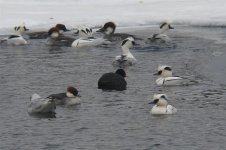Lupus
Active member
Hi,
yesterday I had my first digiscoping attemp using a Canon S95 from a friend with my Zeiss Diascope 85 T*FL
The shot was made handheld without adapter and in quite bad light conditions. I think its pretty ok for that. So I think I'd like to buy this Camera. The only thing is, I read quite bad reviews about the video-mode, which I also would like to use. What do you think about that? Yesterday I was so excited, that I forgot trying out the video-mode ...
Also I was wondering if there are any cheaper but still decent adapters, as the Zeiss quick-camera-adapter costs >400€
Cheers
yesterday I had my first digiscoping attemp using a Canon S95 from a friend with my Zeiss Diascope 85 T*FL
The shot was made handheld without adapter and in quite bad light conditions. I think its pretty ok for that. So I think I'd like to buy this Camera. The only thing is, I read quite bad reviews about the video-mode, which I also would like to use. What do you think about that? Yesterday I was so excited, that I forgot trying out the video-mode ...
Also I was wondering if there are any cheaper but still decent adapters, as the Zeiss quick-camera-adapter costs >400€
Cheers





